Coral bleaching occurs when coral polyps expel the algae called zooxanthellae that live within their tissues. This expulsion is usually triggered by environmental stressors such as increased sea temperatures or pollution. Without these algae, corals lose their vibrant color and essential energy source, making them vulnerable to disease and mortality. The Great Barrier Reef has experienced widespread coral bleaching events, with significant episodes recorded in 2016 and 2017. Satellite data and underwater surveys show that elevated sea surface temperatures caused extensive coral stress. This phenomenon highlights the urgent need for climate change mitigation and water quality management to protect reef ecosystems.
Table of Comparison
| Reef Location | Year | Bleaching Severity | Primary Cause | Consequences |
|---|---|---|---|---|
| Great Barrier Reef, Australia | 2016 | Severe | Marine heatwaves | Mass coral mortality, loss of biodiversity |
| Coral Triangle, Southeast Asia | 2010 | Moderate | Elevated sea surface temperatures | Decreased coral cover, disrupted fisheries |
| Florida Keys, USA | 2014 | Moderate to Severe | Ocean warming and pollution | Reef degradation, decline in tourism revenue |
| Red Sea Coral Reefs | 2015 | Mild to Moderate | Thermal stress from climate change | Reduced coral resilience, altered reef ecosystems |
Understanding Coral Bleaching: Definition and Causes
Coral bleaching occurs when corals expel the symbiotic algae called zooxanthellae, which provide them with essential nutrients and vibrant colors, due to stress factors such as increased sea surface temperatures, ocean acidification, and pollution. This loss leads to the coral turning white and significantly reduces their ability to survive, ultimately threatening reef ecosystems. Key causes include prolonged temperature anomalies often linked to climate change, alongside local stressors like sedimentation and nutrient runoff.
Notable Historical Coral Bleaching Events
The 1998 mass coral bleaching event, driven by an intense El Nino, resulted in the loss of over 16% of global coral reefs, particularly affecting the Great Barrier Reef and Indian Ocean. The 2016 and 2017 back-to-back bleaching events further devastated approximately 30% of the Great Barrier Reef's coral cover, marking it as one of the most severe bleaching crises recorded. These notable historical events highlight the critical impact of rising sea temperatures and climate change on coral reef ecosystems worldwide.
The Great Barrier Reef: A Case Study in Bleaching
The Great Barrier Reef has experienced severe coral bleaching due to rising sea temperatures caused by global climate change. In 2016 and 2017, over 50% of the reef's coral was affected, leading to significant loss of biodiversity and disruption of marine ecosystems. Efforts to monitor water temperature and reduce carbon emissions are critical to protect this UNESCO World Heritage site from further degradation.
Coral Bleaching in the Caribbean Reefs
Coral bleaching in the Caribbean reefs has intensified due to rising sea temperatures, causing widespread loss of symbiotic algae essential for coral survival. Significant bleaching events in 2010 and 2015 led to mortality rates exceeding 50% in some reef systems, disrupting marine biodiversity and fisheries. Persistent bleaching threatens the structural integrity of Caribbean reefs, undermining their role in coastal protection and tourism economies.
Bleaching Episodes in the Maldives and Indian Ocean
Coral bleaching episodes in the Maldives and the broader Indian Ocean have intensified due to rising sea temperatures, with significant events recorded in 1998, 2016, and 2019. These bleaching events have led to widespread degradation of coral reefs, threatening biodiversity and the livelihoods of local communities dependent on marine resources. Studies indicate that ocean warming and acidification are primary drivers, stressing corals and causing them to expel symbiotic algae crucial for their survival.
The Impact of Rising Sea Temperatures on Coral Reefs
Rising sea temperatures cause coral bleaching by disrupting the symbiotic relationship between corals and zooxanthellae algae, leading to the loss of vibrant colors and vital nutrients. The Great Barrier Reef has experienced extensive bleaching events, with over 50% of corals affected during the 2016 and 2017 heatwaves. This thermal stress reduces coral growth rates, increases mortality, and threatens marine biodiversity and reef ecosystem services.
Human Activities Accelerating Coral Bleaching
Human activities such as coastal development, overfishing, and the release of pollutants accelerate coral bleaching by increasing water temperatures and reducing water quality in reef ecosystems. Agricultural runoff introduces excess nutrients, promoting algal blooms that block sunlight essential for coral survival. The emission of greenhouse gases from fossil fuel combustion intensifies ocean warming and acidification, directly contributing to the global weakening of coral reefs.
Ecological Consequences of Coral Reef Bleaching
Coral reef bleaching leads to the loss of symbiotic algae, resulting in reduced coral growth, compromised reef structure, and diminished habitat complexity. This degradation causes declines in marine biodiversity, affecting fish populations that rely on reefs for food and shelter. The weakened reef resilience also disrupts coastal protection, increasing vulnerability to storm surges and erosion.
Local and Global Responses to Coral Bleaching
Local communities have implemented coral gardening and restoration projects to regenerate bleached reefs, improving resilience and biodiversity. Governments and NGOs enforce marine protected areas and reduce coastal pollution to mitigate stressors contributing to bleaching. On a global scale, international agreements like the Paris Agreement aim to limit ocean warming by reducing greenhouse gas emissions, addressing the root cause of widespread coral bleaching.
Future Outlook: Preventing Further Coral Bleaching
Advanced monitoring technologies and targeted restoration efforts are crucial for preventing further coral bleaching in reef ecosystems. Implementing climate-resilient coral species and reducing carbon emissions can enhance reef adaptability to rising sea temperatures. Global collaboration on marine protection policies will significantly improve the future outlook for coral reef conservation.

example of coral bleaching in reef Infographic
 samplerz.com
samplerz.com